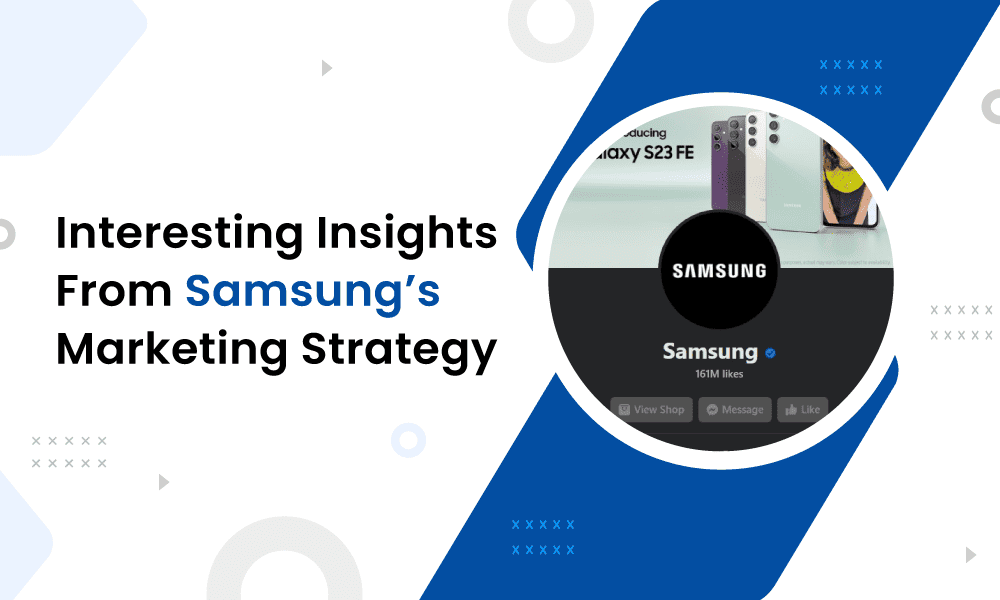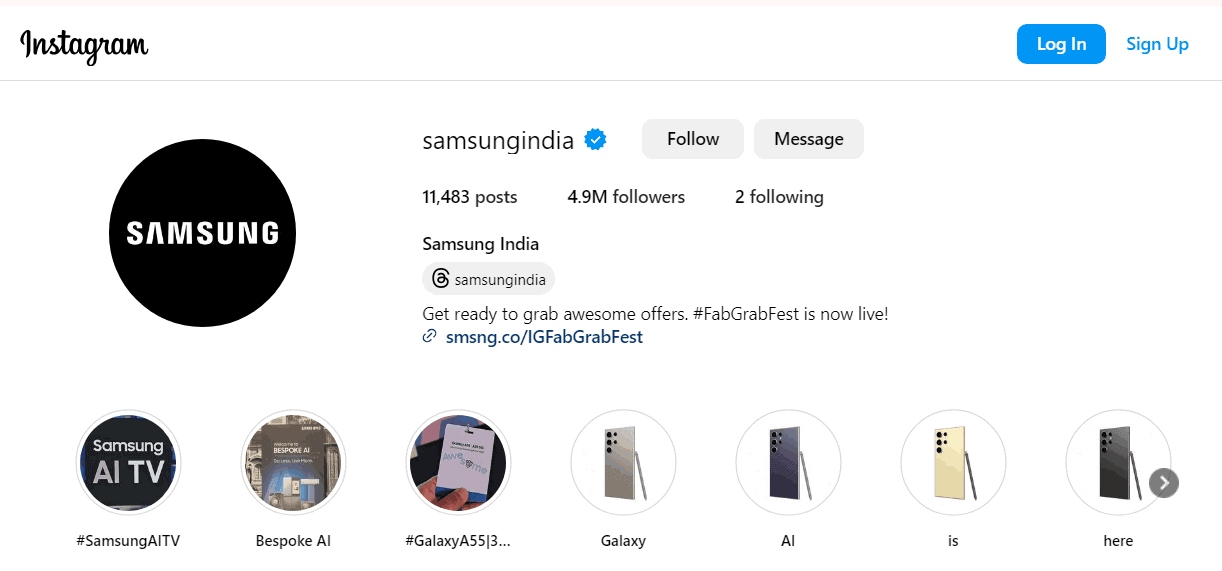Samsung is a titan in the high-octane world of technology, where innovation and brand value are vital. Samsung’s marketing strategy has always been commendable, and it’s no wonder that Samsung has joined the privileged Global Top 5 Brands club for the fourth consecutive year.
Samsung established itself as a forerunner in tech innovation and changed its brand image through a speckless marketing strategy. The result? A stunning market cap of $363.77 billion as of June 2024 and a brand value of $99.4 billion.
These stats are more than just numbers; they’re a testament to Samsung’s unrivaled journey in consumer electronics. This blog post breaks down Samsung’s marketing strategy to understand what they’re doing right.
Table of Contents
Foundation to Evolution – Samsung Roadmap
Samsung, the worldwide behemoth, began its journey in South Korea in 1938. Lee Byung-Chul established Samsung, which means “Three Stars,” as a grocery trading business.

Samsung spent the initial 20 years expanding into the finance, retail, manufacturing, and other sectors before finally joining the consumer electronics market in 1969.
Samsung Electronics Company first partnered with Sanyo Lab to manufacture affordable televisions and microwaves. They ventured into inexpensive consumer goods under the Samsung name via discount stores like Walmart. During the 1997 Asian market crash, their low-price competitive approach worked. However, the sales of Samsung Electronics items fell as the market saw increased competition.
Samsung’s marketing strategy shifted to differentiate itself from its low-tier manufacturing competitors. They turned the spotlight from low-cost and cheap to revolutionary technological innovation under the leadership of Jon Yong Yun. This shift not only enhanced their competitive advantage but also established Samsung as a leading innovator in the global market.
The market reaction to Samsung’s first smartphone, the Galaxy GT-17500, was overwhelmingly positive after its release in June 2009. Soon after, Samsung Electronics released a deluge of phones covering the smartphone industry. Each was better than the last. Each had upgraded unconventional new features, improved hardware, and better protection of personal data.
Thus began the “Do what you can’t” moment– the advertising campaign part of Samsung’s marketing strategy catapulted Samsung to the status of the most lucrative tech corporation in history.
Social Media Presence
The company’s deft utilization of influential currency through social media marketing is critical to Samsung’s digital marketing success. Samsung has social media accounts on every major platform.
- Samsung Mobile’s X (formerly Twitter) page boasts 12.4 million followers
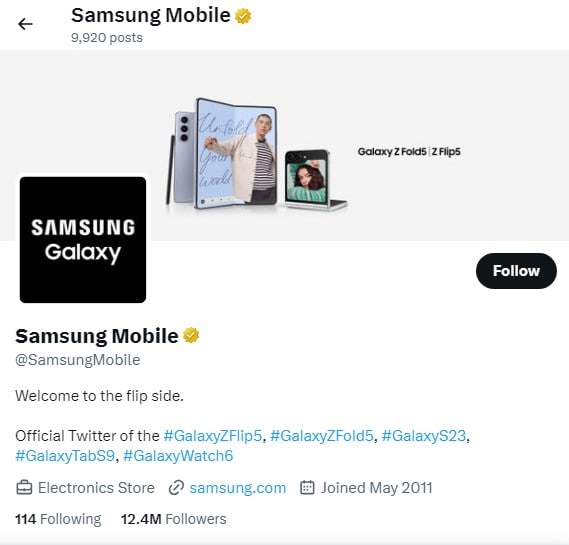
- The Facebook page has 162 million likes
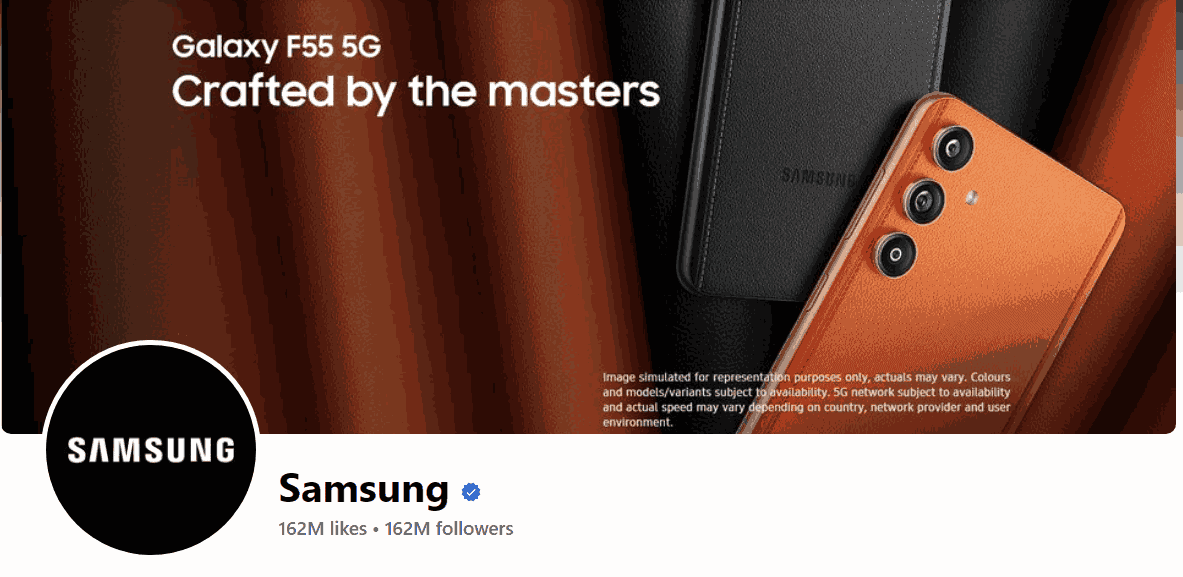
- Samsung India’s community has over 4.9 million Instagram users
- Samsung’s YouTube channel has 6.53 million subscribers
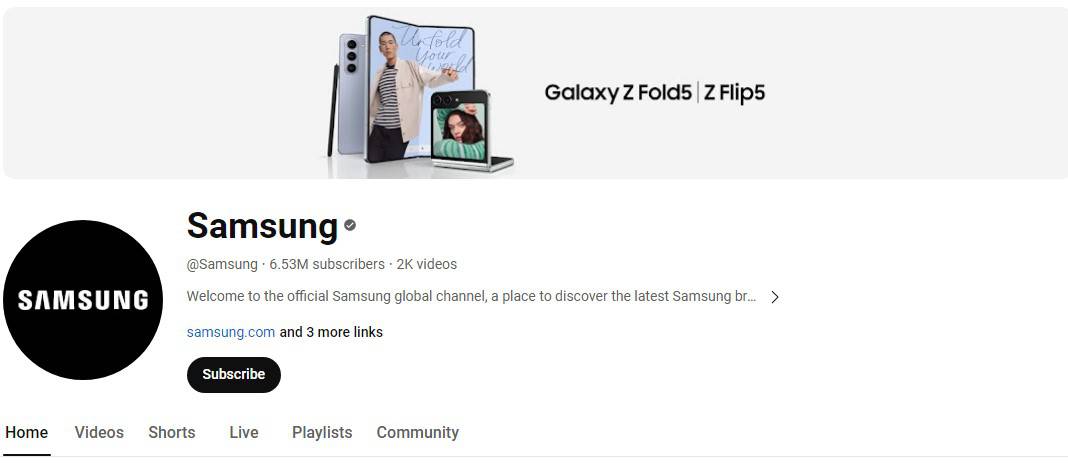
Their active presence and engagement on social media platforms allow the company to reach a diverse audience worldwide. Additionally, Samsung gives consumers and brand advocates more opportunities to share their experiences by increasing its visibility on social media. Here’s a collaborative post with an influencer, for example:
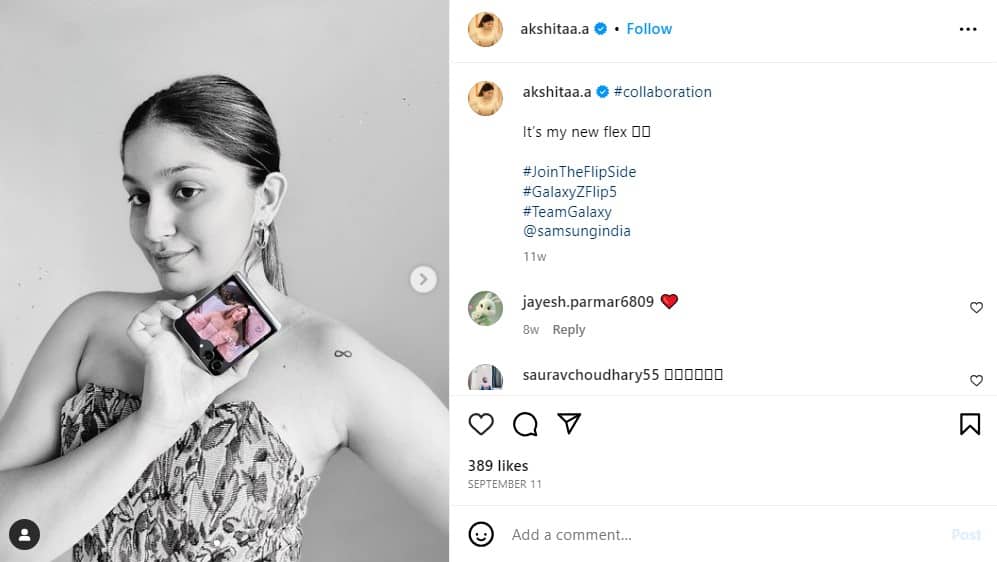
With many such collaborations, Samsung’s marketing strategy leverages influencers’ following and gets more exposure for the Galaxy Z Flip5.
Website Optimization
Search engine optimization (SEO) is essential to overall digital marketing strategy. It raises your website’s visibility. As a result, you get more traffic and a higher likelihood of funneling potential consumers.
Website optimization is necessary for the following:
- People to know your business
- Connect with potential customers
- Establish yourself as an authority in your industry
Samsung Customer Care Department organically incorporated SEO to drive traffic to the website. However, now the company has an SEO team that has grown into a small but formidable in-house unit responsible for:
- Search engine optimization (SEO)
- Search engine marketing (SEM)
- Content strategy
The team has optimized the entire website to ensure Samsung ranks on the first page of the Google search engine. Additionally, platforms like the Samsung Newsroom are crucial in distributing press releases, articles, and multimedia content, further enhancing their online presence.
The results:
- Their organic traffic increased by 4% over the year
- They saw a 12% boost in their keyword rank
- #1 ranking in computers, electronics, and technology in India
- 583.4k unique links to Samsung’s domain
- The domain authority score is an impressive 94

Top keywords that Samsung ranks for:
| Keyword | Rank |
| Samsung | 1 |
| Galaxy | 1 |
| Samsung Galaxy | 1 |
| S22 ultra | 1 |
| Samsung TV | 1 |
| Samsung watches | 1 |
| Samsung watch | 1 |
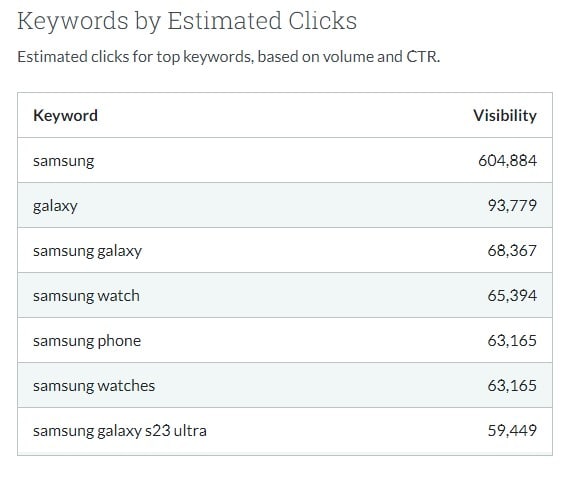
So, what’s the secret?
“It all boils down to, What is the person searching for? What is it they actually wanted? And do we have answers for that?”
~ Scott Messina, Jetson’s VP of Planning and Business Intelligence.
Samsung took a step back to analyze user behavior before optimizing on-site SEO. They aimed to enhance the online experience for all Samsung device users, whether they were looking for the latest Galaxy Watch, the newest Galaxy phone, or any other Samsung product. Samsung followed a holistic approach by considering the needs of all their customers across every page. Their SEO team’s main goal was to ensure that customers could easily find exactly what they wanted when searching for something.
Samsung’s Marketing Mix
The balanced marketing mix is the core of Samsung’s marketing strategy. Marketing mix combines a business’s many promotional strategies to increase awareness of its name and products. Samsung’s marketing mixes include the four Ps:
- Product
- Price
- Place
- Promotion
The marketing mix strategy of Samsung:
- Product: Offer a variety of high-quality items
- Place: In retail shops and online
- Price: At a premium or competitive pricing, depending on consumer demand
- Promotion: Spread the word with digital campaigns, ads, content marketing, sales promotions, and in-person events
Let’s examine in detail the company’s use of the marketing mix to stay ahead of the competition.
Samsung’s strong social media presence is a crucial part of their strategy.
Product mix strategy
The company focuses on customers’ wants and offers various Samsung products with the quirkiest tech innovations and the highest quality. The Samsung product strategy is designed to meet the demands of its target market by:
- Keep tabs on emerging market trends in the industry
- Add modifications as per changes with the times
- Develop goods accordingly
The Samsung product categories include:
- Smartphones
- Tablets
- Cameras
- Televisions
- Smart home devices
- Air Conditioners
- Refrigerators
- Printers
- Laptops
- IT accessories
- Washing machine
Read also: How Netflix Marketing Wins Audience Every Time
Enhance Your Email Marketing
Want to make your emails more impactful? Check out our beautiful, easy-to-customize technology email templates. Designed to boost engagement, these templates from EngageBay will help your emails stand out. Just customize the images, headings, and CTAs for your brand, and hit send in a few minutes!
Pricing mix strategy
The pricing strategy is a strong suit of Samsung’s marketing approach. Samsung faces stiff competition in the smartphone market. Competitors constantly release new devices with similar and better specs in a matter of weeks. To counter this, Samsung employs two pricing strategies:
- Price skimming: Every time Samsung releases a new smartphone, it sets the maximum price buyers are ready to spend.
- Competitive pricing: As the novelty wears off and rivals release the same features, Samsung cuts prices to maintain a competitive hold on market share.
One of Samsung’s strengths is that it can satisfy all your electronic device needs without breaking the bank. For this reason, Samsung Group and its affiliated companies contribute over 22% of South Korea’s GDP.
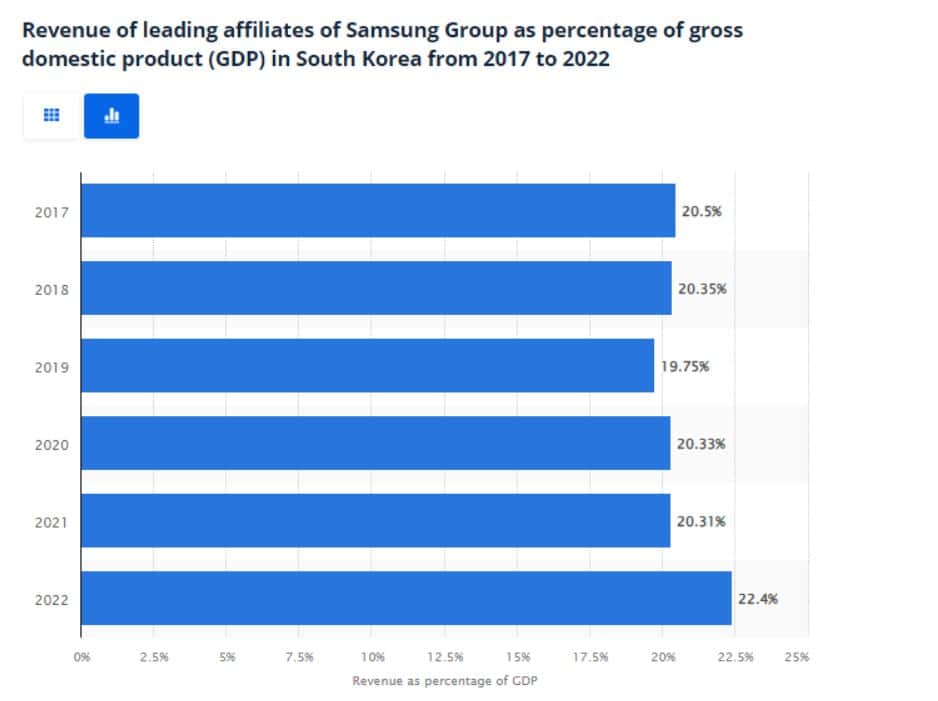
Place mix strategy
Samsung has a smart distribution strategy. The only customers that Samsung sells to are service dealers and retailers operated by the company.
Be it online or offline, Samsung’s focus is always on customers. Samsung’s marketing strategy is to market itself as a brand with dealers all around the globe who are:
- Attentive to customers
- Dedicated to them
- Quickly respond to customer care inquiries
This distribution strategy ensures its diverse and innovative product offerings are available worldwide.
Central to the Samsung product strategy is prioritizing customer convenience, including the comfort of buying from home with an easy-to-use eCommerce store. This store is characterized by:
- User-friendly interface
- Detailed product descriptions
- Easy to navigate categorization
Read also: How to Maximize ROI With Strategic Product Placement
Promotion mix strategy
Samsung keeps aside a massive budget for marketing and promotion. In 2022, Samsung paid close to $2.57 billion for ads in the US alone. To reach its demographic and raise its profile, Samsung employs various promotional strategies, such as:
- Digital marketing
- Public relation
- Sales promotions
- Personal selling
- Advertisements
Samsung segmentation is a key aspect of their approach, which helps them target specific customer groups more effectively. Discounts and incentives are a solid part of Samsung’s marketing strategy to stay competitive. Its use of digital ads is daring with unconventional messaging.
Read also: Perks & Examples of Customer Oriented Companies
The Key Elements of Samsung’s Marketing Strategy
Samsung’s marketing campaigns aim for three things:
- Reach the intended consumers
- Increase product sales
- Strengthen relationships with existing customers
To achieve this, Samsung equips itself with different digital marketing strategies, such as:
- Sponsorships and partnerships to create more brand awareness
- Celebrity endorsements to boost sales
- Use of social media for continuous contact with customers
Let’s look at their different strategies to understand what helps them succeed at marketing.
Read also: 16 Top Business Movies Every Entrepreneur Must Watch
Celebrity endorsements and brand ambassadors
When a beloved celebrity endorses a product, who wouldn’t buy it? Celebrity endorsement is a powerful part of Samsung’s marketing strategy to influence the target audience.
From sports celebrities to Music artists, the company has partnered with numerous high-profile celebs, such as:
- Lionel Messi, Cristiano Ronaldo, Wayne Rooney, and more, in their 2013 commercial
- Collab with Amir Khan and Priyanka Chopra as brand ambassadors in 2010
- Release of banging collab with Bangtan Boys (BTS) in two digital films in 2022
Sponsorships and partnerships
Name a better way to reach a broad audience than showing side-by-side with the most notable brands or at the most awaited events of the year.
Samsung’s everywhere! At the Olympics, with Guild Esports and Channel 4, TwitchCon Paris, New York and London Fashion Weeks, and many more.
Through these collaborations, partnerships, and sponsorships, Samsung reaches a tremendous audience to raise awareness of its diverse and innovative products.
An innovative approach to emotional tweaks
We all know the power of storytelling in marketing, and Samsung doesn’t undermine it either. Samsung’s marketing strategy involves carefully crafting every piece of content in each marketing campaign to narrate stories that reach the audience’s hearts. Take, for example, this ad about customer service:
The struggles Amit, the customer service agent, goes through to reach a visually impaired customer are heart-rending. The story captures the audience’s attention and maintains a solid interest, evoking numerous emotions throughout the journey.
Such branding goes beyond marketing the company’s products. It demonstrates the business’ dedication to addressing social issues.
Almost every company that wants to make a difference in the world participates in social responsibility activities. Samsung addresses these issues in its advertising campaigns. These things work together to make people think well of Samsung, which is excellent for the company’s reputation.
Read also: Dunkin Donuts Marketing Strategy: A Deep Dive
Samsung Italy’s social responsibility initiative
Samsung’s marketing strategy also focuses on social initiatives. Samsung developed PizzAut, an app for individuals with autism to manage a restaurant business. It is part of Samsung Italy’s meaningful social responsibility initiative created by the collaboration of FCB Milan’s:
- Engineers
- User experience designers
- Psychotherapists
- Language specialists
Samsung Italy designed it with the aim of creating an inclusive work environment for autistic persons.

And, the funny side
Adding a touch of fun to its marketing strategies, Samsung consistently finds new ways to poke fun at Apple. “Let us know when it folds,” reads a tweet from 2022 that pokes fun at Apple’s product launch.
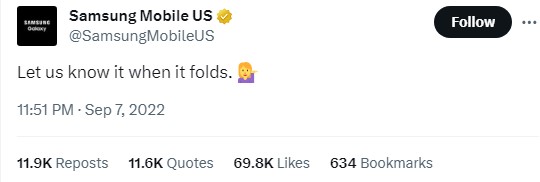
The tweet alludes to the fact that the two brands continuously outdo each other regarding storage capacity, camera specifications, water resistance, and other characteristics. But guess what? You can’t fold an iPhone – at least not yet!
Several smartphone users engage in the conversion, many applauding Samsung’s humor while many engage with arguments.

Lastly, the commendable customer service
Let’s not forget their efforts to provide customer service on every platform. Customers often reach out, commenting on the blogs and social media posts seeking support. Samsung always takes advantage of opportunities to stay in touch with customers and help them.
These efforts attest to their unwavering commitment to keeping their customers happy. In addition, it also acknowledges its marketing genius to keep existing customers engaged.
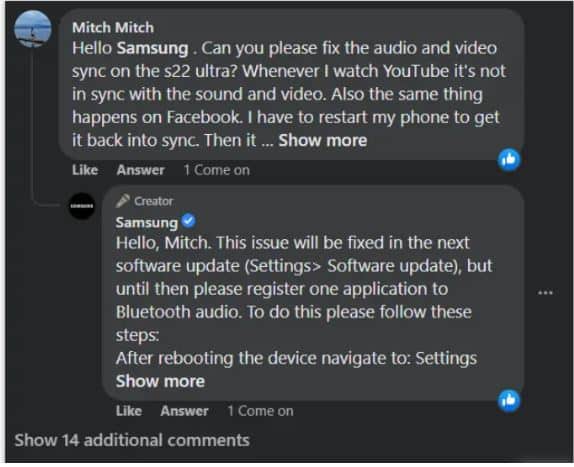
Read also: Amazon Marketing Strategy Case Study for The Curious
Samsung’s Most Successful Digital Marketing Campaigns
Samsung’s marketing campaigns have a reputation for being both creative and effective. The brand relies on three pillars in its advertising strategy for effective marketing messaging:
- How its product features inspire innovation
- How does the product improve the lifestyle of its users
- How the company beats the competitors
Our favorite five Samsung campaigns through the years genuinely illustrate the core of Samsung’s marketing strategies.
1. Monster Trail Marketing Campaign
Limitations in battery life are the bane of our connected generation. Samsung released the #GoMonster campaign in India, unveiling Galaxy M3 to answer our woes. It promoted an “always on” lifestyle, spotlighting its tremendous battery life.
The campaign video features Amith Sadh. He takes the Samsung Galaxy M3 on a Monster Trail from Leh to Henle, the highest astronomical observatory. Just charging the phone once keeps him company through the riskiest mountainous terrain.

2. EpicDreamsOf21 Marketing Campaign
Mobile phones are increasingly competitive with camera specs. To lead the competition, Samsung is a pioneer in offering more and more features in camera specs.
#EpicDreamsof21 is an artistic reveal for Galaxy S21 Ultra 5G in 2021. It showcases the phone’s revolutionary 108MP camera that can capture every detail of the larger picture to illustrate its art.

3. Look at Me Marketing Campaign
We discussed how Samsung’s marketing strategy addresses social issues. In the Look at Me project, Caitlin’s story, Samsung shows how its Look at Me app helps children tackle the difficulties of autism. The app claims to improve communication skills by interpreting facial expressions and maintaining eye contact. It’s a perfect example of how Samsung offers innovation to solve real-world social problems.

4. Join the Flip Side Marketing Campaign
Joining The Flip Side campaign is a jab at the competitors (The Apple loyalists? Shh, we didn’t say anything!). The campaign’s message showcases Samsung’s commitment to innovation.
The message is clear—instead of buying phones with essentially the same features and look year after year, “Join the Flip Side.” The flip side is a place of innovative creativity—a place of the company’s new foldable range of technology.

5. Galleried Marketing Campaign
With the slogan “TV when it’s on, Art when it’s off,” Samsung illustrates an out-of-box way of advertising TV.
Art enthusiasts are shocked to see the strange disappearance of priceless artworks from their frames while visiting the museum. Many worried onlookers gaze upon empty frames in the places where paintings formerly were. What’s the explanation? When Samsung TVs are on, they’re art.

Read also: Coach Marketing Strategy: Crafting the Game Plan for Success
SWOT Analysis
A SWOT analysis is one way to identify and analyze a company’s strengths and weaknesses. SWOT stands for:
- Strengths
- Weaknesses
- Opportunities
- Threats
When used to analyze marketing strategies, it looks at potential opportunities and challenges that can influence the actualization of a marketing goal.
Let’s use this method to examine Samsung’s marketing approach and determine why it works:

Strengths of Samsung’s marketing strategy
- A diverse range of products when compared to other players in the industry
- A customer-centric approach to marketing
- Use of their commitment to social issues to build emotional connections with consumers
- Quick adoption of new technologies to fuel innovation and build a strong brand image
- Strong presence around the world with online and offline market
Weaknesses of Samsung’s marketing strategy
- Product faults in foldable phones and exploding batteries damage consumer confidence
- Hereditary leadership limits the input of fresh ideas
- Scandals, such as the bribery scandal of 2015 and others, jeopardize the company’s image
Read also: IKEA Marketing Strategy: A-Z Analysis of the Winning Formula
Opportunities for Samsung’s marketing strategy
- Chance to gain a competitive edge by investing in HR to bag highly qualified talents.
- Possibility to achieve tremendous development by being the innovative trendsetter in changing consumer demands.
- The Exynos 2200 processor shows a lot of potential for outstanding performance and graphics in smartphone gaming.
Threats to Samsung’s marketing strategy
- Apple’s patent infringement lawsuit caused immense damage to the company’s reputation.
- The competition is getting thicker by the day, with players like Xiaomi, Huawei, and Apple constantly making efforts to outperform each other.
- The changing regulatory landscape poses an obstruction to operations.
- The reliance on the US market poses a threat as the US economy becomes increasingly uncertain.
- Samsung’s executive chairman, Jay Lee, faces several allegations and violations that threaten the leadership of the organization.
Read also: 6 High-Impact eCommerce Marketing Strategies to Try Now
Results of Samsung’s Marketing Efforts
Samsung’s focus on innovation in its marketing efforts, along with a strategy focused on user behavior, has harnessed record-breaking results over the years. Check out these facts that attest to the genius of its marketing tactics:
- Samsung sold 500 phones each minute after the release of Galaxy S3.
- In 2022, Samsung captured 31.1% of the 5G smartphone market.
- The company supplied 90.2 million 5G devices with a CAGR of 136% from 2021 to 2022.
- Samsung Galaxy A52 was the best seller of all Android 5G smartphones in 2022.
- In 2023, the company’s brand value grew by 4% despite a worldwide slowdown in the IT industry.
- Using market capitalization, the company is the 24th most valuable organization as of May 28, 2023.
- 30.5% of smartphone users worldwide prefer the Samsung Note series, making it the most popular smartphone.
Read also: Top Retail Marketing Strategies To Grow Your Business
Conclusion
Samsung’s rise from a modest grocery trading company to a technological giant is a story of savvy marketing at the heart of unrelenting innovation and customer-centric methods. The company’s massive success in leveraging the power of digital platforms, a well-balanced marketing mix, and creative campaigns has profoundly embedded the Samsung brand in the consumer psyche.
A crucial component of this success is Samsung’s meticulously crafted marketing plan, which guides its strategies and actions. Their capacity to adapt, innovate, and emotionally connect with consumers became critical in creating market domination and brand value.
Samsung’s marketing strategy, a mix of old and updated digital systems, continues to be an outstanding case study for all businesses worldwide. Samsung’s journey is a beacon of strategic foresight, fueling its path to long-term success.
EngageBay is an all-in-one marketing and automation software for all your marketing needs. With our free and easy-to-customize HTML email templates, you can create eye-catching email campaigns that your customers will love. Try EngageBay today!
FAQ
What makes Samsung’s digital marketing strategy stand out in the tech industry?
Establishing a memorable brand identity is essential to Samsung’s marketing approach. The organization uses a consumer-centric strategy to make its products and brand identity stand out from the competition.
What marketing strategies does Samsung use?
Samsung uses digital and print marketing strategies to promote its products and create a strong brand image. The Samsung marketing strategy is a combination of the following elements:
- Digital marketing
- Public relation
- Sales promotions
- Personal selling
- Advertisements
What makes Samsung’s pricing strategy unique?
Samsung has successfully struck a strategic pricing structure that sets a high price when the company releases a new smartphone. Over time, the company reduces prices to remain competitive in the market.
What is Samsung’s market entry strategy?
They often enter new markets by adapting their products to local preferences, forming strategic business partners, and investing in extensive marketing campaigns. Samsung employs a diverse market entry strategy tailored to different regions and product lines.
What is Samsung’s long-term strategy?
Samsung’s long-term strategy centers on sustainability. This initiative aims to achieve net-zero emissions in the Device Experience (DX) division by 2030, with a broader vision for the entire company to achieve this milestone by 2050. Samsung’s long-term strategy also focuses on innovation and technological advancements. The company consistently invests in research and development to stay at the forefront of emerging technologies.
Content updated for freshness and SEO by Swastik Sahu.
